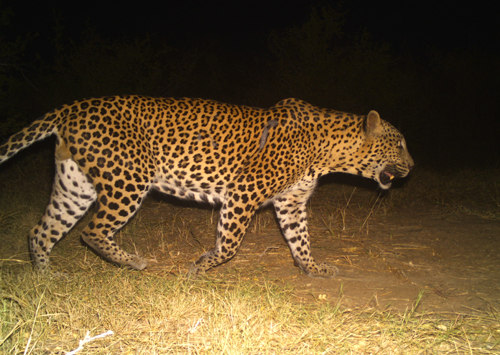Back to where the Big Cat roams

A handsome leopard captured on camera. Pic courtesy Dinal Samarasinghe
Some interesting details are shared by researcher and wildlife biologist Dinal Samarasinghe (33) as Sri Lanka celebrates Leopard Day today (August 1), with a strong plea to preserve not only the Wilpattu National Park but also Protected Areas and Other State Forests (OSFs) hugging its boundaries. This would facilitate the protection of this exotic species and the predator-prey link which would enable leopards to continue to thrive, unlike elsewhere in the country and globally where their numbers are dwindling.
Sri Lanka Leopard Day has been declared on a proposal of the Wildlife and Nature Protection Society (WNPS) with one of the objectives being to ‘rivet’ attention on this species which is vulnerable to extinction. A joint declaration has been issued by the Department of Wildlife Conservation and the WNPS.
Looking closely at the lives of leopards, Dinal says that leopards are known to be solitary, going on walkabouts alone except when they are mating or the female has cubs. He fondly refers to a “big bloke”, a handsome dominant male, which is an inveterate loafer and “owns” a large territory.
The leopard is the only apex predator in the country, he says, explaining that it is at the top of the food chain. Sub-fossil evidence points to other predators such as tigers and wild dogs being here but from around 10,000 years ago, the leopard has been the sole apex predator, with the exception of humans, on the island.
Shouldering everything they needed for a full day’s work, the team crisscrossed the 1,316 sq.ft. National Park, from early morn, around 6 until 6 in the evening as the shadows lengthened, for five months from May to September 2018 – seeing the leopards (Panthera pardus kotiya) in their element during the day and capturing on camera traps their roaming at night.

On a mission: Dinal (centre back) and his team
This research has been undertaken by Dinal, Dr. Eric D. Wikramanayake, Dr. Alex Braczkowski, Rukshan Jayewardene, Dr. Arjun Gopalaswami, Jehan Kumara, Dr. Justine Alexander and Kithsiri Gunawardena, with institutional backing from the Environmental Foundation Limited (EFL) and the Leopard Trust.
The team went into Wilpattu to estimate population numbers (density) and structure in a large landscape. Long were the days, covering distances of 10-12km and stopping only for a simple breakfast or a late afternoon meal, provided by Kulu Safari, of rice, karawala (dried fish) and sambol or string hoppers and egg curry.
Numerous were the wild animals they stumbled upon on their forays to fix the camera traps – the tree snakes were non-venomous, laughs Dinal but there had been a heart-stopping moment when they had a close encounter with a bear, just an arm’s distance away.
“It was amidst the sand dunes and it was the bark of the bear that alerted us to how close we were to it,” he says, reliving that moment of terror. Fortuitously for them, the bear had decided on the option of “flight” rather than “fight”.
A scuffle in the shrubs, meanwhile, had drawn their attention to a bolting flash of gold and black – a leopard taking off, allowing curiosity to prevail until they came quite close.
Having walked the length and breadth of Wilpattu, the researchers are now being beckoned by other National Parks to carry out similar leopard studies.
| Leopards masters of all they survey at Wilpattu; let’s keep it that way | |
| The Wilpattu National Park is a “major and important source” of leopards to the surrounding areas, Dinal and his team found to their delight, counting around 133 leopards – 116 “independents” and 17 “dependents”.The density of leopards at Wilpattu was in the “upper range” when compared to populations around the world. Except in some areas in India, Java in Indonesia and some fenced areas of Africa, the populations are showing a downward trend.Dinal says that with the Wilpattu National Park leopards being the masters of all they survey even in Protected Areas on its immediate boundaries such as Wilpattu North Sanctuary and Mavillu Conservation Forest to the north and Weerakkodicholai Forest Reserve, Tabbowa Sanctuary and Ipalogama Forest Reserve to the south, “we need to take a close look at the dangers confronting them”. These dangers include:
Dinal stresses that for a leopard population to thrive, there should also be good prey density along with an excellent habitat which is not fragmented. Leopards need to have a choice, otherwise they would have to be content with not-so-tasty morsels and then they would be compelled to make inroads into human habitat. Commending the concerted efforts of the Department of Wildlife Conservation team at this National Park to prevent poaching, he explains that when there is tourism, there is a natural curb on poaching. Meanwhile, Dinal appeals to local holiday-goers to refrain from seeking the meat of wild animals such as deer and boar which, in turn, will pre-empt the hunting of such animals.
|
| Plea to safeguard parks and forests | |
| The Fauna and Flora Protection Ordinance (FFPO) has prescribed certain ‘prohibitions’ and ‘limitations’ on development activities within a one-mile radius from the boundary of any National Reserve including National Parks.“Let’s ensure that this status quo is strictly maintained,” urges wildlife biologist Dinal Samarasinghe, adding a passionate plea to safeguard Other State Forests (OSFs) which are also vital for the survival of wild animals.He cites the study titled, ‘A biodiversity hotspot in turmoil: Doing away with circular 5/2001 could have catastrophic consequences for Sri Lanka’s forests’ published in April in the respected journal ‘Conservation Science and Practice’ of Wiley Periodicals. The study was by EFL’s Dinal Samarasinghe, Eric D. Wikramanayake, Sevvandi Jayakody, Suranjan Fernando and Jagath Gunawardana and Alexander Braczkowski of the Centre for Planetary Health and Food Security, Griffith University, Nathan, Queensland, Australia & School of Natural Resource Management, Nelson Mandela University, George, South Africa. The paper states that in 2017, Sri Lanka set a goal to increase its forest cover to 32% by 2030. But in November 2020, the government published circular MWFC/1/2020 revoking circular 5/2001 of August 10th 2001, one of the country’s most crucial forest protection directives. The revocation of the 5/2001 circular could severely hamper this target, posing a threat of deforestation to a variety of ecosystems which are not part of any formally designated Protected Areas (PAs), also known as OSFs, it states. Underscoring that OSFs include forested areas adjoining PAs which are “crucial” for habitat connectivity and standalone state forest lands, the paper has pointed out that such a “retrograde” step could have potentially catastrophic ramifications on Sri Lanka’s declining forest cover. “It would also severely weaken the country’s commitments to the UN-REDD Programme (the United Nations Collaborative Programme on Reducing Emissions from Deforestation & forest Degradation); the Kyoto Protocol; and the Convention on Biological Diversity. We, therefore, call on the government to urgently reconsider and reverse this decision,” the team added. |


